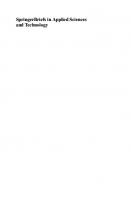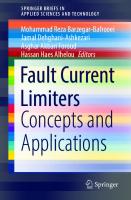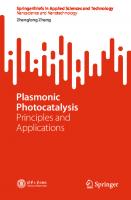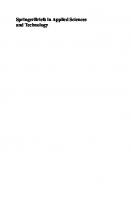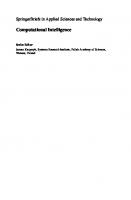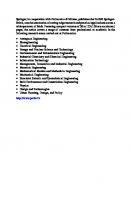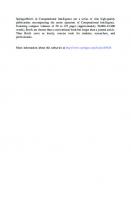Field-based Tests for Soccer Players: Methodological Concerns and Applications (SpringerBriefs in Applied Sciences and Technology) 3031038940, 9783031038945
This book systematically summarizes the accuracy, precision, and repeatability levels of field-based tests applied in so
133 12 1MB
English Pages 120 [115] Year 2022
Contents
1 Introduction
1.1 Rationale for Understanding Accuracy, Precision, and Repeatability Levels of Field-Based Tests
References
2 Systematically Revising the Literature of Field-Based Soccer Tests
2.1 Methods
2.2 Eligibility Criteria
2.3 Information Sources and Search
2.4 Data Extraction
2.5 Data Items
2.6 Methodological Assessment
2.7 Study Identification and Selection
2.8 Methodological Assessment
References
3 Characteristics of the Included Tests
3.1 Physical Tests
References
4 Reliability Levels of the Tests
References
5 Discussion of Field-Based Soccer Tests for Aerobic Fitness
References
6 Discussion of Field-Based Soccer Tests for Sprinting, Change-Of-Direction, and Agility
6.1 Linear and Curvilinear Sprinting
6.2 Change of Direction Sprinting
6.3 Repeated Sprint Ability (RSA)
6.4 Agility
References
7 Discussion of Field-Based Soccer Tests for Strength and Power
7.1 Concurrent Validity of Strength and Power Tests
7.2 Reliability of Strength and Power Tests
7.3 Limitations, Future Research, and Practical Implications
7.4 Conclusion
References
Recommend Papers

File loading please wait...
Citation preview
SpringerBriefs in Applied Sciences and Technology Filipe Manuel Clemente · Rafael Oliveira · Rui Silva · Zeki Akyildiz · Halil Ibrahim Ceylan · Javier Raya González · Francisco Tomás González Fernández · Rui Araújo · Hugo Sarmento · Ricardo Lima · Bruno Silva · Sérgio Matos · Yung-Sheng Chen · José Afonso
Field-based Tests for Soccer Players Methodological Concerns and Applications
SpringerBriefs in Applied Sciences and Technology
SpringerBriefs present concise summaries of cutting-edge research and practical applications across a wide spectrum of fields. Featuring compact volumes of 50 to 125 pages, the series covers a range of content from professional to academic. Typical publications can be: • A timely report of state-of-the art methods • An introduction to or a manual for the application of mathematical or computer techniques • A bridge between new research results, as published in journal articles • A snapshot of a hot or emerging topic • An in-depth case study • A presentation of core concepts that students must understand in order to make independent contributions SpringerBriefs are characterized by fast, global electronic dissemination, standard publishing contracts, standardized manuscript preparation and formatting guidelines, and expedited production schedules. On the one hand, SpringerBriefs in Applied Sciences and Technology are devoted to the publication of fundamentals and applications within the different classical engineering disciplines as well as in interdisciplinary fields that recently emerged between these areas. On the other hand, as the boundary separating fundamental research and applied technology is more and more dissolving, this series is particularly open to trans-disciplinary topics between fundamental science and engineering. Indexed by EI-Compendex, SCOPUS and Springerlink.
More information about this series at https://link.springer.com/bookseries/8884
Filipe Manuel Clemente · Rafael Oliveira · Rui Silva · Zeki Akyildiz · Halil Ibrahim Ceylan · Javier Raya González · Francisco Tomás González Fernández · Rui Araújo · Hugo Sarmento · Ricardo Lima · Bruno Silva · Sérgio Matos · Yung-Sheng Chen · José Afonso
Field-based Tests for Soccer Players Methodological Concerns and Applications
Authors See next page
ISSN 2191-530X ISSN 2191-5318 (electronic) SpringerBriefs in Applied Sciences and Technology ISBN 978-3-031-03894-5 ISBN 978-3-031-03895-2 (eBook) https://doi.org/10.1007/978-3-031-03895-2 © The Author(s), under exclusive license to Springer Nature Switzerland AG 2022 This work is subject to copyright. All rights are solely and exclusively licensed by the Publisher, whether the whole or part of the material is concerned, specifically the rights of translation, reprinting, reuse of illustrations, recitation, broadcasting, reproduction on microfilms or in any other physical way, and transmission or information storage and retrieval, electronic adaptation, computer software, or by similar or dissimilar methodology now known or hereafter developed. The use of general descriptive names, registered names, trademarks, service marks, etc. in this publication does not imply, even in the absence of a specific statement, that such names are exempt from the relevant protective laws and regulations and therefore free for general use. The publisher, the authors and the editors are safe to assume that the advice and information in this book are believed to be true and accurate at the date of publication. Neither the publisher nor the authors or the editors give a warranty, expressed or implied, with respect to the material contained herein or for any errors or omissions that may have been made. The publisher remains neutral with regard to jurisdictional claims in published maps and institutional affiliations. This Springer imprint is published by the registered company Springer Nature Switzerland AG The registered company address is: Gewerbestrasse 11, 6330 Cham, Switzerland
Filipe Manuel Clemente Escola Superior Desporto e Lazer Instituto Politécnico de Viana do Castelo Viana do Castelo, Portugal
Rafael Oliveira Sports Science School of Rio Maior Polytechnic Institute of Santarém Rio Maior, Portugal
Rui Silva Escola Superior Desporto e Lazer Instituto Politécnico de Viana do Castelo Viana do Castelo, Portugal
Zeki Akyildiz Sports Science Department Gazi University Ankara, Turkey
Halil Ibrahim Ceylan Physical Education and Sports Teaching Department Kazim Karabekir Faculty of Education Ataturk University Erzurum, Turkey
Javier Raya González Faculty of Health Sciences Universidad Isabel I Burgos, Spain
Francisco Tomás González Fernández Department of Physical Education and Sport, Faculty of Education and Sport Sciences Campus of Melilla, University of Granada Melilla, Spain Hugo Sarmento Faculty of Sport Sciences and Physical Education, University of Coimbra—Research Unit for Sport and Physical Activity Coimbra, Portugal Bruno Silva Escola Superior Desporto e Lazer Instituto Politécnico de Viana do Castelo Viana do Castelo, Portugal Yung-Sheng Chen Department of Exercise and Health Sciences University of Taipei Taipei, Taiwan
Rui Araújo University Institute of Maia—ISMAI Maia, Portugal Ricardo Lima Escola Superior Desporto e Lazer Instituto Politécnico de Viana do Castelo Viana do Castelo, Portugal Sérgio Matos Escola Superior Desporto e Lazer Instituto Politécnico de Viana do Castelo Viana do Castelo, Portugal José Afonso Faculty of Sport Centre for Research, Education, Innovation and Intervention in Sport University of Porto Porto, Portugal
Contents
1 Introduction . . . . . . . . . . . . . . . . . . . . . . . . . . . . . . . . . . . . . . . . . . . . . . . . . . . 1.1 Rationale for Understanding Accuracy, Precision, and Repeatability Levels of Field-Based Tests . . . . . . . . . . . . . . . . . . References . . . . . . . . . . . . . . . . . . . . . . . . . . . . . . . . . . . . . . . . . . . . . . . . . . . . .
1 1 2
2 Systematically Revising the Literature of Field-Based Soccer Tests . . . . . . . . . . . . . . . . . . . . . . . . . . . . . . . . . . . . . . . . . . . . . . . . . . . . . . . . . . 2.1 Methods . . . . . . . . . . . . . . . . . . . . . . . . . . . . . . . . . . . . . . . . . . . . . . . . . . 2.2 Eligibility Criteria . . . . . . . . . . . . . . . . . . . . . . . . . . . . . . . . . . . . . . . . . . 2.3 Information Sources and Search . . . . . . . . . . . . . . . . . . . . . . . . . . . . . . 2.4 Data Extraction . . . . . . . . . . . . . . . . . . . . . . . . . . . . . . . . . . . . . . . . . . . . 2.5 Data Items . . . . . . . . . . . . . . . . . . . . . . . . . . . . . . . . . . . . . . . . . . . . . . . . . 2.6 Methodological Assessment . . . . . . . . . . . . . . . . . . . . . . . . . . . . . . . . . 2.7 Study Identification and Selection . . . . . . . . . . . . . . . . . . . . . . . . . . . . . 2.8 Methodological Assessment . . . . . . . . . . . . . . . . . . . . . . . . . . . . . . . . . References . . . . . . . . . . . . . . . . . . . . . . . . . . . . . . . . . . . . . . . . . . . . . . . . . . . . .
5 5 5 7 11 11 11 12 12 14
3 Characteristics of the Included Tests . . . . . . . . . . . . . . . . . . . . . . . . . . . . . 3.1 Physical Tests . . . . . . . . . . . . . . . . . . . . . . . . . . . . . . . . . . . . . . . . . . . . . . References . . . . . . . . . . . . . . . . . . . . . . . . . . . . . . . . . . . . . . . . . . . . . . . . . . . . .
15 15 30
4 Reliability Levels of the Tests . . . . . . . . . . . . . . . . . . . . . . . . . . . . . . . . . . . . References . . . . . . . . . . . . . . . . . . . . . . . . . . . . . . . . . . . . . . . . . . . . . . . . . . . . .
33 79
5 Discussion of Field-Based Soccer Tests for Aerobic Fitness . . . . . . . . . References . . . . . . . . . . . . . . . . . . . . . . . . . . . . . . . . . . . . . . . . . . . . . . . . . . . . .
87 91
6 Discussion of Field-Based Soccer Tests for Sprinting, Change-Of-Direction, and Agility . . . . . . . . . . . . . . . . . . . . . . . . . . . . . . . . 6.1 Linear and Curvilinear Sprinting . . . . . . . . . . . . . . . . . . . . . . . . . . . . . . 6.2 Change of Direction Sprinting . . . . . . . . . . . . . . . . . . . . . . . . . . . . . . . .
95 95 96
vii
viii
Contents
6.3 Repeated Sprint Ability (RSA) . . . . . . . . . . . . . . . . . . . . . . . . . . . . . . . 6.4 Agility . . . . . . . . . . . . . . . . . . . . . . . . . . . . . . . . . . . . . . . . . . . . . . . . . . . . References . . . . . . . . . . . . . . . . . . . . . . . . . . . . . . . . . . . . . . . . . . . . . . . . . . . . .
97 98 99
7 Discussion of Field-Based Soccer Tests for Strength and Power . . . . . 7.1 Concurrent Validity of Strength and Power Tests . . . . . . . . . . . . . . . . 7.2 Reliability of Strength and Power Tests . . . . . . . . . . . . . . . . . . . . . . . . 7.3 Limitations, Future Research, and Practical Implications . . . . . . . . . 7.4 Conclusion . . . . . . . . . . . . . . . . . . . . . . . . . . . . . . . . . . . . . . . . . . . . . . . . References . . . . . . . . . . . . . . . . . . . . . . . . . . . . . . . . . . . . . . . . . . . . . . . . . . . . .
103 104 105 107 108 108
Chapter 1
Introduction
1.1 Rationale for Understanding Accuracy, Precision, and Repeatability Levels of Field-Based Tests Assessment of athletic performance in soccer has part of the periodic process of monitoring the player’s adaptations over the season (Enright et al. 2018). Such period assessment allows coaches to individualize the training process based on the current status of the players and, eventually, identify the responses of the players to the training stimulus provided between assessments (Clemente et al. 2019). Therefore, the assessment of athletic performance is a support and orientation process allowing coaches to, possibly, better design training process and sooner identify trajectories of fitness development of the players (McLaren et al. 2018). This is of paramount importance considering the biological heterogeneity of the players to the similar and/or standardized training stimulus (Muñoz-López and Naranjo-Orellana 2020). Usually, different tests are used for assessing the athletic performance in soccer due to the multidimensional factors of performance (Murr et al. 2018). Therefore, amongst other possibilities, testing battery for the assessment of athletic performance in soccer players includes (Turner et al. 2011): (a) vertical jump height (e.g., squat, countermovement jump and/or drop jump); (b) a linear speed, acceleration, and change-of-direction test; (c) muscular strength and power test; and (d) an aerobic capacity test (e.g., yo-yo intermittent recovery test, 30–15 intermittent fitness test). Other possibilities as repeated-sprint ability (Wragg et al. 2000), or horizontal jump (Chamari et al. 2008) tests can be also assessed. The application of field-based tests became predominant in soccer due to the easyto-use process and trying to achieve a higher specificity (Da Silva et al. 2011). In fact, trying to overcome the tension between the high reliability and low ecological validity of laboratorial tests and the low reliability and high validity of field-based methods (Reilly et al. 2009), an increase in the assessment of accuracy, precision, and repeatability articles related to the use of field-based tests was observed even in systematic reviews about specific tests (Grgic et al. 2020; Grgic et al. 2019). In © The Author(s), under exclusive license to Springer Nature Switzerland AG 2022 F. M. Clemente et al., Field-based Tests for Soccer Players, SpringerBriefs in Applied Sciences and Technology, https://doi.org/10.1007/978-3-031-03895-2_1
1
2
1 Introduction
fact, the determination of measurement error statistics such as the technical error of measurement is critical due to the fact that wrong inferences can be performed regarding human responses, whilst the issue can be related to the measurement test (Atkinson et al. 2019). Therefore, knowing the accuracy, precision, and repeatability levels of field-based tests in different soccer populations (age-groups, sexes, competitive levels) is determinant to allow identify the error associated with the use of each specific test and allow coaches and sports scientist to use the most appropriate tests for each population. Although the existence of some articles and reviews dedicated to the summary of evidence about accuracy and/or precision of field-based tests (Grgic et al. 2020, 2019), they are restricted to a specific test and do not covering all the possibilities and taking into consideration the adequation for different populations. The systematization of accuracy, precision, and repeatability of different fieldbased tests in soccer in a unique book may help coaches and sports scientists to have an overview of the state-of-the-art about the topic, potentially allowing them to make decisions about the most appropriate tests to use in practice. This, in this book the readers will have access to the following items: (a) summary of the accuracy, precision, and repeatability levels of field-based tests applied in soccer; (b) list of the accurate, precise, and repeatability field-based tests to different age-groups and sexes; and (c) description of the field-based tests and typical values.
References G. Atkinson, P. Williamson, A.M. Batterham, Issues in the determination of ‘responders’ and ‘nonresponders’ in physiological research. Exp. Physiol. 104(8), 1215–1225 (2019). https://doi.org/ 10.1113/EP087712 K. Chamari, A. Chaouachi, M. Hambli, F. Kaouech, U. Wisløff, C. Castagna, The five-jump test for distance as a field test to assess lower limb explosive power in soccer players. J. Strength Cond. Res. 22(3), 944–950 (2008). https://doi.org/10.1519/JSC.0b013e31816a57c6 F.M. Clemente, P.T. Nikolaidis, T. Rosemann, B. Knechtle, Dose-response relationship between external load variables, body composition, and fitness variables in professional soccer players. Frontiers Physiol.10 (2019).https://doi.org/10.3389/fphys.2019.00443 J.F. Da Silva, L.G.A. Guglielmo, L.J. Carminatti, F.R. De Oliveira, N. Dittrich, C.D. Paton, Validity and reliability of a new field test (Carminatti’s test) for soccer players compared with laboratorybased measures. J. Sports Sci. 29(15), 1621–1628 (2011). https://doi.org/10.1080/02640414. 2011.609179 K. Enright, J. Morton, J. Iga, D. Lothian, S. Roberts, B. Drust, Reliability of “in-season” fitness assessments in youth elite soccer players: a working model for practitioners and coaches. Sci. Med. Football 2(3), 177–183 (2018). https://doi.org/10.1080/24733938.2017.1411603 J. Grgic, B. Lazinica, Z. Pedisic, Test-retest reliability of the 30–15 intermittent fitness test: a systematic review. J. Sport Health Sci. 0–20 (2020).https://doi.org/10.1016/j.jshs.2020.04.010 J. Grgic, L. Oppici, P. Mikulic, J. Bangsbo, P. Krustrup, Z. Pedisic, Test-retest reliability of the yo-yo test: a systematic review. Sports Med. 49(10), 1547–1557 (2019). https://doi.org/10.1007/ s40279-019-01143-4 S.J. McLaren, A. Smith, J.D. Bartlett, I.R. Spears, M. Weston, Differential training loads and individual fitness responses to pre-season in professional rugby union players. J. Sports Sci. 36(21), 2438–2446 (2018). https://doi.org/10.1080/02640414.2018.1461449
References
3
A. Muñoz-López, J. Naranjo-Orellana, Individual versus team heart rate variability responsiveness analyses in a national soccer team during training camps. Sci. Rep. 10(1), 11726 (2020). https:// doi.org/10.1038/s41598-020-68698-5 D. Murr, J. Raabe, O. Höner, The prognostic value of physiological and physical characteristics in youth soccer: a systematic review. Eur. J. Sport Sci. 18(1), 62–74 (2018). https://doi.org/10.1080/ 17461391.2017.1386719 T. Reilly, T. Morris, G. Whyte, The specificity of training prescription and physiological assessment: a review. J. Sports Sci. 27(6), 575–589 (2009). https://doi.org/10.1080/02640410902729741 A. Turner, S. Walker, M. Stembridge, P. Coneyworth, G. Reed, L. Birdsey, J. Moody, et al.: A testing battery for the assessment of fitness in soccer players. Strength Conditioning J.33, 29–39 (2011).https://doi.org/10.1519/SSC.0b013e31822fc80a C.B. Wragg, N.S. Maxwell, J.H. Doust, Evaluation of the reliability and validity of a soccer-specific field test of repeated sprint ability. Eur. J. Appl. Physiol. 83(1), 77–83 (2000). https://doi.org/10. 1007/s004210000246
Chapter 2
Systematically Revising the Literature of Field-Based Soccer Tests
2.1 Methods This systematic review followed the Cochrane Collaboration guidelines (Green and Higgins 2005). The systematic review strategy was conducted according to PRISMA (Preferred Reporting Items for Systematic Reviews and Meta-analyses) guidelines (Moher et al. 2009). The PICOS (Population, Intervention/exposure, Comparator, Outcome, Study design) was defined as follows: (P) soccer players from any agegroup, sex, or competitive level; (I) exposed to a field-based test; (C) gold-standard methods and/or concurrent field-based tests; (O) performance measures in the fieldbased test; (S) no restrictions were placed in terms of study design. The protocol was published in INPLASY (International Platform of Registered Systematic Review and Meta-analysis Protocols) with the identification number of INPLASY202130099 and https://doi.org/10.37766/inplasy2021.3.0099.
2.2 Eligibility Criteria The inclusion and exclusion criteria can be found in Table 2.1.
Population
Inclusion criteria
Exclusion criteria
Healthy soccer players from any age group, competitive level, or sex
Sports other than soccer (e.g., American football, Australian rules football, futsal, beach football, basketball), physical education students, general population Players with pathologies (e.g., cerebral palsy) (continued)
© The Author(s), under exclusive license to Springer Nature Switzerland AG 2022 F. M. Clemente et al., Field-based Tests for Soccer Players, SpringerBriefs in Applied Sciences and Technology, https://doi.org/10.1007/978-3-031-03895-2_2
5
6
2 Systematically Revising the Literature of Field-Based …
(continued) Inclusion criteria Intervention/exposure Exposed to a field-based test with or without ball, covering the physical qualities of: (i) aerobic performance; (ii) anaerobic performance; (iii) strength and power; (iv) sprint and change-of-direction; and/or (v) mobility
Exclusion criteria Technical and tactical tests; laboratorial tests (e.g., cycling, treadmill, weight room); tests assessing mental fatigue or other psychological constructs For the case of repeatability and/or comparison—single application of single test (because no comparison is possible) Pre- post- after intervention program (changes will be due to intervention) if single target test is applied (with more than one test, at least, their comparison is possible) Repeated single test, but where experimenters purposefully manipulated the conditions and therefore the two tests were performed under very different circumstances Simple monitoring of load parameters during small-sided games, official matches or tactical-technical drills (e.g., using GPS)
Comparator
For comparison purposes, the For comparison purposes, having tests must be compared with a no gold-standard test or concurrent laboratorial goal-standard test field-based test and/or with a concurrent field-based test For reliability purposes, no comparator is required beyond having at least two time points for a single test
Outcome
Measures of accuracy/precision (e.g., typical error; mean absolute error) and/or repeatability (e.g., intraclass correlation test; coefficient of variation)
No statistics provided in relation to accuracy/precision and/or repeatability Therefore, it is not enough that two or more tests are presented in a single application—the authors must have presented data of their correlation/association For single test reliability—authors must have presented data addressing reliability
Study design
No restrictions regarding study design. In case of more than one time point, both (pre- and post-) will be considered
—
(continued)
2.3 Information Sources and Search
7
(continued) Inclusion criteria Other
Exclusion criteria
Only original and full-text studies Written in languages other than written in English, Portuguese, English, Portuguese, Spanish, Spanish, Italian, and French Italian, and French. Other article types than original (e.g., reviews, letters to editors, trial registrations, proposals for protocols, editorials, book chapters, and conference abstracts)
The screening of the title, abstract, and reference list of each study to locate potentially relevant studies was independently performed by the two authors (FMC and JA). Additionally, they reviewed the full version of the included papers in detail to identify articles that met the selection criteria. An additional search within the reference lists of the included records was conducted to retrieve additional relevant studies. A discussion was made in the cases of discrepancies regarding the selection process with a third author (RO). Possible errata for the included articles were considered.
2.3 Information Sources and Search Electronic databases (EBSCO, PubMed, Scielo, Scopus, SPORTDiscus, Web of Science) were searched for relevant publications on March 29, 2021. Keywords and synonyms were entered in various combinations in title and/or abstract, with two code lines for free terms [(soccer OR football) AND (“Validity” OR “Accuracy” OR “Reliability” OR “Precision” OR “Variability” OR “Repeatability” OR “Reproducibility” OR “Consistency”)] AND one code line for MeSH terms (“exercise test” OR “muscle strength” OR “physical fitness”). In Scielo, search was conducted in all fields, without limitation to title or abstract; this was done both due to characteristics of its search engine, and because this database usually delivers a smaller number of results. MeSH terms could only be applied to PubMed; therefore, in the remaining databases, the third line of code could not follow protocol, and was open to free terms in all fields. Additionally, the protocol had established that the reference lists of the studies retrieved would be manually searched to identify potentially eligible studies not captured by the electronic searches. Finally, an external expert would be contacted to verify the final list of references included in this review in order to understand if there was any study that was not detected through our research. However, due to the sheer number of articles that were included in the final sample (>100), we decided not to proceed with these two additional steps.
8
2 Systematically Revising the Literature of Field-Based …
Table 2.1 Synthesis of the methodological assessment related with the included articles Item/article (No OR unable to determine = 0 ||| Yes = 1)
Average rating
Reporting — 1. Is the hypothesis/aim/objective of the study clearly described?
1.0
2. Are the main outcomes to be measured clearly described in the Introduction 1.0 of Methods section? [If the main outcomes are first described in the Results section, the answer should be “no”] 3. Are the characteristics of the patients included in the study clearly described? [In cohort studies and trials, inclusion and/or exclusion criteria should be given. In case–control studies, a case definition and the source for controls should be given]
0.9
4. Are the interventions of interest clearly described? [Treatments and 1.0 placebo—where relevant—that are to be compared should be clearly described] 5. Are the distributions of principal confounders in each group of subjects to be 0.3 compared clearly described? [A list of principal confounders is provided.] No—0; Partially—1; Yes—2 6. Are the main findings of the study clearly described? [Simple outcome data—including denominators and numerators—should be reported for all major findings so that the reader can check the major analyses and conclusions.] This question does not cover statistical tests, which are considered below
1.0
7. Does the study provide estimates of the random variability in the data for the 1.0 main outcomes? [In non-normally distributed data, the inter-quartile range of results should be reported. In normally distributed data, the SE, SD, or CI should be reported. If the distribution of the data is not described, it must be assumed that the estimates used were appropriate and the question should be answered yes.] 8. Have all important adverse events that may be a consequence of the intervention been reported? [This should be answered yes if the study demonstrates that there was a comprehensive attempt to measure adverse events. A list of possible adverse events is provided.]
0.1
9. Have the characteristics of patients lost to follow-up been described? [This should be answered yes where there were no losses to follow-up or where losses to follow-up were so small that findings would be unaffected by their inclusion. This should be answered no where a study does not report the number of patients lost to follow-up.]
0.7
10. Have actual probability values been reported (e.g., 0.035 rather than
